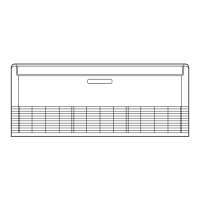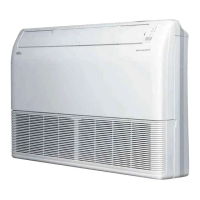4.3. Flare connection (pipe connection)
4.3.1. Flaring
UsespecialpipecutterandaretoolexclusiveforR410A.•
Cut the connection pipe to the necessary length with a (1)
pipe cutter.
Hold the pipe downward so that cuttings will not enter the (2)
pipe and remove any burrs.
Insertthearenut(alwaysusethearenutattachedto(3)
the indoor and outdoor units respectively) onto the pipe
andperformtheareprocessingwithaaretool.Usethe
specialR410Aaretool,ortheconventionalaretool.
Leakageofrefrigerantmayresultifotherarenutsare
used.
Protect the pipes by pinching them or with tape to prevent (4)
dust, dirt, or water from entering the pipes.
Pipe outside
diameter
[mm (in.)]
Dimension A [mm]
Dimension B
-
0
0.4
[mm]
Flare tool for R410A,
clutch type
6.35 (1/4)
0 to 0.5
9.1
9.52 (3/8) 13.2
12.70 (1/2) 16.6
15.88 (5/8) 19.7
19.05 (3/4) 24.0
WhenusingconventionalaretoolstoareR410Apipes,
thedimensionAshouldbeapproximately0.5mmmorethan
indicatedinthetable(foraringwithR410Aaretools)to
achievethespeciedaring.Useathicknessgaugetomeas-
ure the dimension A.
Pipe outside
diameter [mm (in.)]
Width across ats
of Flare nut [mm]
6.35 (1/4) 17
9.52 (3/8) 22
12.70 (1/2) 26
15.88 (5/8) 29
19.05 (3/4) 36
Use pipe with water-resistant heat insulation.•
CAUTION
Install heat insulation around both the gas and liquid •
pipes. Failure to do so may cause water leaks.
Use heat insulation with heat resistance above 120 °C.
(Reverse cycle model only)
In addition, if the humidity level at the installation loca-
tionoftherefrigerantpipingisexpectedtoexceed70%,
install heat insulation around the refrigerant piping.
Iftheexpectedhumiditylevelis70-80%,useheat
insulationthatis15mmorthickerandiftheexpected
humidityexceeds80%,useheatinsulationthatis20mm
or thicker. If heat insulation is used that is not as thick as
specied,condensationmayformonthesurfaceofthe
insulation.
In addition, use heat insulation with heat conductivity of
0.045 W/(m·K) or less (at 20 °C).
4. PIPE INSTALLATION
CAUTION
Be more careful that foreign matter (oil, water, etc.) does •
not enter the piping than with refrigerant R410A models.
Also, when storing the piping, securely seal the openings
by pinching, taping, etc.
While welding the pipes, be sure to blow dry nitrogen gas •
through them.
4.1. Selecting the pipe material
CAUTION
Donotuseexistingpipes.•
Usepipesthathavecleanexternalandinternalsides•
without any contamination which may cause trouble dur-
inguse,suchassulfur,oxide,dust,cuttingwaste,oil,or
water.
It is necessary to use seamless copper pipes. •
Material:Phosphordeoxidizedseamlesscopperpipes
It is desirable that the amount of residual oil is less than
40 mg/10 m.
Do not use copper pipes that have a collapsed, de-•
formed, or discolored portion (especially on the interior
surface).Otherwise,theexpansionvalveorcapillarytube
may become blocked with contaminants.
Improper pipe selection will degrade performance. As an •
air conditioner using R410A incurs pressure higher than
when using conventional refrigerant, it is necessary to
choose adequate materials.
Thicknesses of copper pipes used with R410A are as shown •
in the table.
Never use copper pipes thinner than those indicated in the •
table even if they are available on the market.
Thicknesses of Annealed Copper Pipes (R410A)
Pipe outside diameter [mm (in.)] Thickness [mm]
6.35 (1/4) 0.80
9.52 (3/8) 0.80
12.70 (1/2) 0.80
15.88 (5/8) 1.00
19.05 (3/4) 1.20
4.2. Pipe requirement
CAUTION
Refer to the Installation Manual of the outdoor unit for •
description of the length of connecting pipe or for differ-
ence of its elevation.
Diameter [mm (in.)]
Liquid 9.52 (3/8)
Gas 15.88 (5/8)

